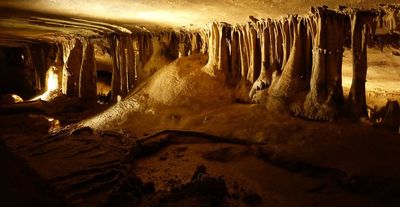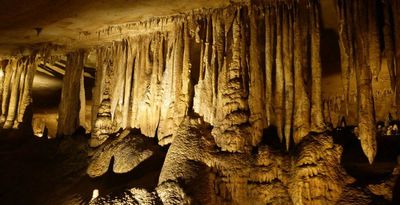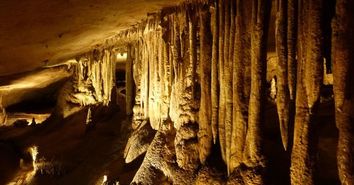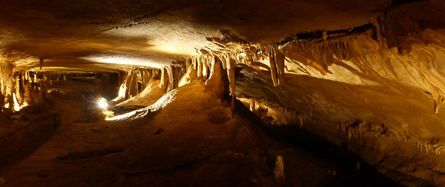Down the length of this cave passage extends a partial wall of closely spaced stalactites and columns. In a few places there are gaps wide enough for someone to pass through. In some other places, the partition is fully solid with joined-together columns and mounded-up floor deposits. The main passage diminishes in height toward its end, becoming too low for a person to stand, but a side passage, visible through gaps in the stalactite curtain, branches off to provide a second exit from this area.
Dimensions The stalactite curtain extends for 200 feet (60 m), running off-center in the passage (space on one side of the curtain is 40 feet (12 m) wide, but only ten feet (3 m) wide on the other). Ceiling height is about ten feet (3 m) - a dashed line marks off passage less than four feet high. The schematic map shows passage walls (medium gray), columns (dark gray), contour curves for sloping mounds of cave deposits, and shallow pools (light gray), on a five-foot (1.5 m) grid. A larger-area image for this schematic map is available for download on the FOR GAME MASTERS page.
Key Details
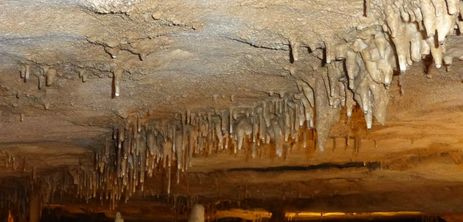
- Origin: In caves it is common to find stalactites lined up along fracture lines in the ceiling, with stalagmites similarly aligned on the floor below. (This is because much of the water dripping into a cave enters along fracture lines, bringing in the dissolved carbonate minerals that deposit to form these cave features.) In this room, that process has been so active over the centuries below one particular fracture line, that grown-together stalactites and stalagmites have formed a line of thick columns dividing the room.
- In the wide, open area of passage on one side of the stalactite curtain, the floor is quite flat until the floor and ceiling join in a concave wall on the outer edge of the passage opposite the curtain, and at the far end where the main passage disappears. In many places it is easy to stand right up against the curtain. The main passage extends in one direction an additional 500 feet beyond this area, before branching and joining an even larger tube-like section of the cave.
- In the more constricted area on the opposite side of the stalactite curtain, the floor drops about five feet on stacked mounds of cave floor deposits. These mounds make the floor more irregular, and because they slope away from the line of columns, they also make stable footing harder to find next to that dividing partition.
- The side passage extending beyond the stalactite curtain is fairly wide, but much of this width is occupied by scattered columns and shallow pools. Ceiling height is about ten feet (3 m), low enough to block clear view of the elevated stalactite curtain if a person is more than 50 feet (30 m) down that side passage.
- This spot is some distance from the cave entrance, so the air remains still even when weather conditions are changing on the surface.
Story Elements
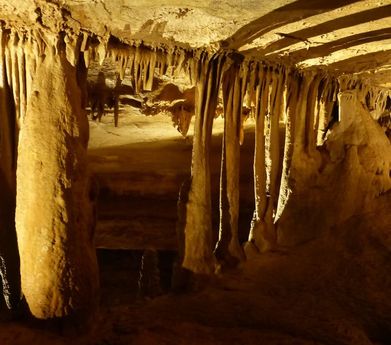
- The wall of columns provides opportunity for spies or to listen in on meetings or observe other events from concealment. As described above and shown on the map, one side of the columns is easier to crouch against than the other.
- This striking, open area might seem an excellent place to mark milestones, such as births, weddings, coming-of-age ceremonies and large community decisions. The wall of columns might symbolize the support of the ancestors.
- Bright light in any single location will cast stark shadows elsewhere in the passage, especially on· the opposite side of the stalactite curtain.
- The fact that the stalactite curtain separates an area easy to traverse from one with more difficult, chancy footing could mirror something else in a story. The larger passage could be the edge of ‘known’ space, with entry to the side passage marking the beginning of an adventure.
- The main passage is broad and even enough for train tracks or a smooth, paved walkway. This could be station used to transport people, remove minerals or other resources, or bring in goods to store and /or hide.
- In a confrontation between people on either side of the curtain, what would happen in that largest gap? Who would stand there?
- The low-ceilinged outer edges of the main passage are less frequently traveled. What might be left behind/forgotten there? Creatures much larger than people might be unable to pass the wall of columns. For creatures much smaller, the stalactite curtain might provide little barrier.
- This large room, deep in the cave and relatively easy to light, could host any manner of illicit activity by an individual or group. Casino? Counterfeiting? Mad scientists? Hell Fire Club? Armageddon machine development?
- If smoke or other gas is released in this area, it will take days to dissipate.
- Combat Dynamics:
- The stalactite curtain provides a protective screen for fighters with distance weapons. Being right up against the columns will give maximum range of view of the other side, and best opportunities for concealment, but also may place snipers within reach of hand-weapon attacks through the screen.
- If projectiles are directed through the curtain from some distance away, some will ricochet severely to left and right.
- Fighters in the elevated, open part of the main passage will have more ease of movement than those on the rougher terrain of the lower side.
- Fighters may try to bypass the stalactite curtain by following its full length on the constricted side, to where it ends and allows access to the rest of the main passage. If opponents on the other side are not on watch close to the curtain, then the fighters will be able to move with some concealment, especially if lighting is dim. However if they are discovered, these fighters may face a gauntlet of projectiles coming through the screen while they try to advance or flee.
Reference Location
Marengo Cave, near town of Marengo, south-central Indiana. Private show cave, open to the public.
© Rice-Snows 2017
Proudly powered by Weebly
